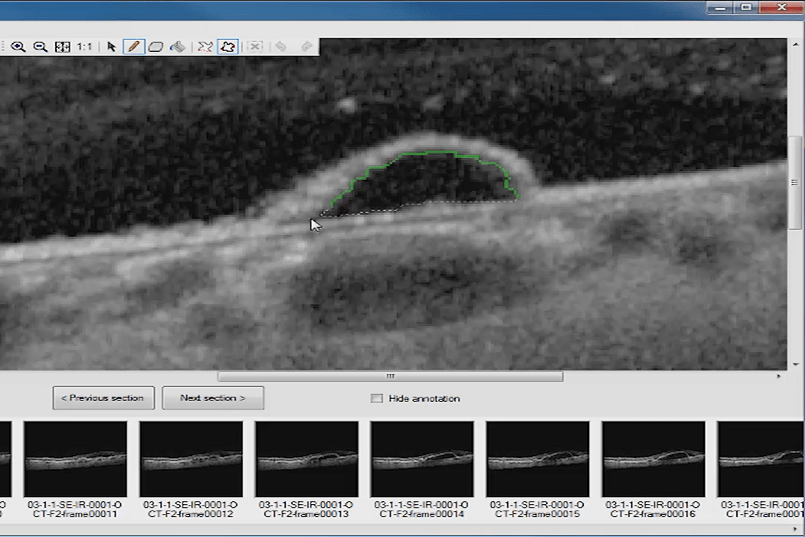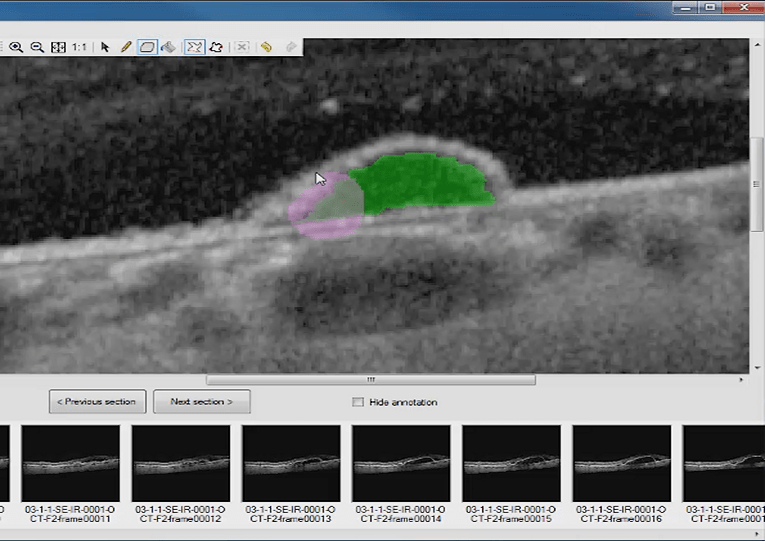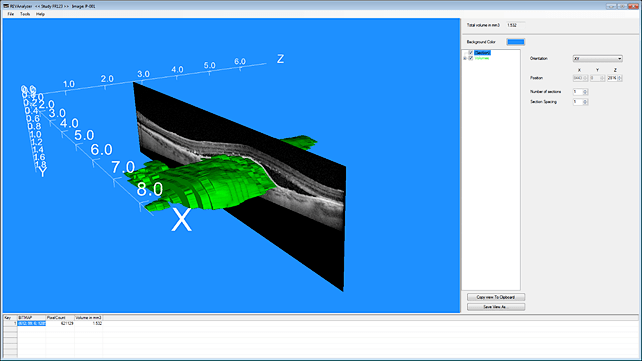Software Product to Quantify the Volume of Retinal Pigment Epithelium Detachment in Macular Area
ReV Analyzer (Retinal Volume Analyzer) is a software product that takes as input OCT images of a patient, detects and analyzes the retinal Pigment Epithelium Detachment (PED) in a series of images, generates a 3D volume in the 3D space, and provides information on the PED evolution over different patient visits. It also works on other retinachoroidal areas in a semi-automatic way.
ReV Analyzer General Description
ReVAnalyzer can be used for patients with vascularized PEDs in the scope of exudative Age Related Macula Degeneration, when the PED is visible in multi modal images, although the analysis is performed in OCT images.

Outline detachment using the User Assisted tool that automatically fits to the boundary of the detachment
Typically, an ophthalmologic clinical examination is performed on a patient during multiple visits, and images of fluorescein and ICG angiography are captured, along with an SD OCT examination in Enhanced Depth Imaging (EDI) mode. The set of OCTimages is saved by the capture system, and then shared between that system and RevAnalyzer.
ReV Analyzer is fully compatible with the Spectralis HRA+OCT system manufactured by the company Heidelberg Engineering GmbH, Heidelberg, Germany.A retinal volume of 61 lines, centered on the fovea is captured using the Spectralis system. The volume is then exported from the Heidelberg system and automatically imported into the ReVAnalyzer software, without any user interaction. Images are stored in a patient database to help organizing visits, images, and volume measurement.

Eraser tool used to adjust the detection
ReV Analyzer Capabilities
Once the volume is opened in the software, the PED area is detected by the operator. Two detection modes are available: A semi-automaticmode that lets the user outline the detachment in each section where it is visible, using a User Assisted tool that automatically fits to the boundary of the detachment. An automatic mode is also available that detects the detachment in the central section, once the user has manually specified that section, and then propagates through all the sections where the detachment is present. In both modes, the user is capable of visually validating the detection in each section, and using a Pen/Eraser tool to adjust the detection.
Once the detection is completed, the software automatically reconstructs and displays the PED in 3D. A full set of display parameters is available to let the user adjust the display in terms of color and orientation, display a section along with the 3D volume, zoom in and out, and move the PED in all directions.
The computed volume is provided in pixels and calibrated unit (cubic millimeter).ReVAnalyzer can track the evolution of a detachment over multiple visits for a given patient, and provide a report that can be printed and saved.

3D volume and section display
ReV Analyzer Main Benefits
ReV Analyzer had been developed to meet the needs of the researchers in the field of ophthalmology, large pharmaceutical companies dealing with clinical studies, as well as private ophthalmologists performing patient monitoring through multiple visits.
- Very accurate computation of a PED volume
- Very intuitive user interaction to detect the PED
- Patient database included in the software
- Fully compatible with the Heidelberg Spectralis system
Acknowledgments
ReV Analyzer has been specified and fully validated by the team of Pr. Eric Souied, Créteil, France. A semi-automated analysis has been performed by three independent readers, twice. Inter and intra reader coefficients were computed based on the Bland Altman statistical method. The analysis was performed on 20 eyes of 20 patients. The value of the coefficient was above 0.99, and the location and size of the PED did not have any impact on the results.
